#Willem de Kooning Academy
Text



Fake advertisements I designed back when I was attending art academy two years ago, the project was a concept for an ad blocker that would replace advertisements with public art.
View the concept here:
925.university/Parasite.html
(Hover over the fake ads)
#webcore#advertisements#internetcore#net art#ad blocker#adblock#public art#art school#art academy#Willem de Kooning Academy#concept#concept art#contemporary art#digital art#post internet#gif#doctors hate him#sexy singles in your area#click here#eyestrain#tw flashing lights#flashing lights#tw flashing#epilepsy#seizure warning#me
6 notes
·
View notes
Text

LEONARD NELSON
AMERICAN, 1912 - 1993
Leonard Nelson was born Leonard Louis Nelson in Camden, New Jersey on March 5, 1912. Orphaned at the age of 16, Nelson, along with his two sisters lived on trust funds until the stock-market crash of 1929 left them destitute.
In the autumn of 1936, Nelson won a scholarship to the Pennsylvania Academy of the Fine Arts in Philadelphia, though he lacked both a portfolio and a formal art education. He was in fact the Cresson Traveling Fellowship.
After six weeks of touring both Eastern and Western Europe, Nelson returned to Philadelphia and the Academy, earning his certificate in 1939. He took classes at the Barnes Foundation in Merion, Pennsylvania from 1939 to 1941 and became friend with Dr. Barnes and Bertrand Russell, the British philosopher and mathematician.
Drafted into the Army in 1942, Nelson became a Private in the Medical Detachment at Fort Eustis, Virginia. During that time, he designed murals and humorous drawings for the hospital to which he was assigned, as well as for the Works Progress Administration.
After his Honorable Discharge from the Army on September 15, 1943, Nelson focused all his attention on his art, holding shows and participating in exhibitions in Philadelphia and New York City. During that time, he was influenced by Native American art and the Native American-inspired murals of Rufino Tamayo and Diego Rivera.
By the mid 1940s, strong relationships with dealers Peggy Guggenheim and Betty Parsons helped Nelson prosper in the fledgeling New York School. He began to exhibit in the New York galleries, in particular Parsons' gallery. His work reflected the Abstract Expressionist style made famous by this school. Jackson Pollock, Lee Krasner, Willem de Kooning, Adolph Gottlieb, and many others from the New York School were among his contemporaries.
By the late 1940s and early 1950s, Nelson was changing direction. He began taught art at the Moore College of Art in Philadelphia, and began painting in a style that was all his own; a combination of gestural Abstract Expressionism, Color Field, and landscape art. The New York art world disavowed it, nevertheless, it went onto become his signature style.
Baker Schorr
25 notes
·
View notes
Photo

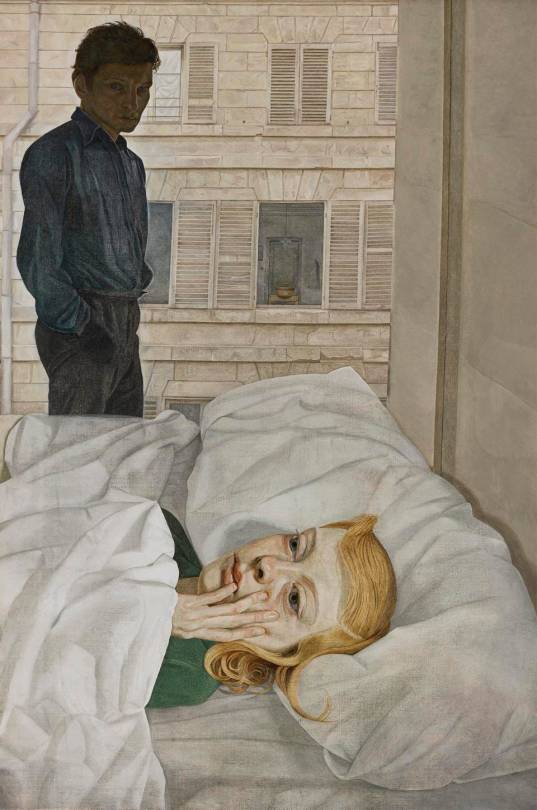
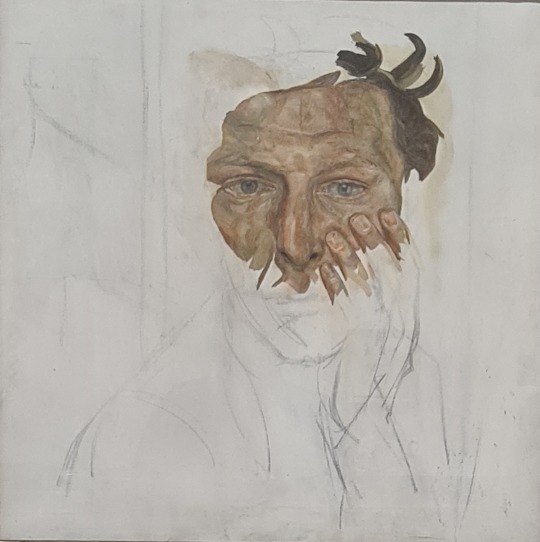
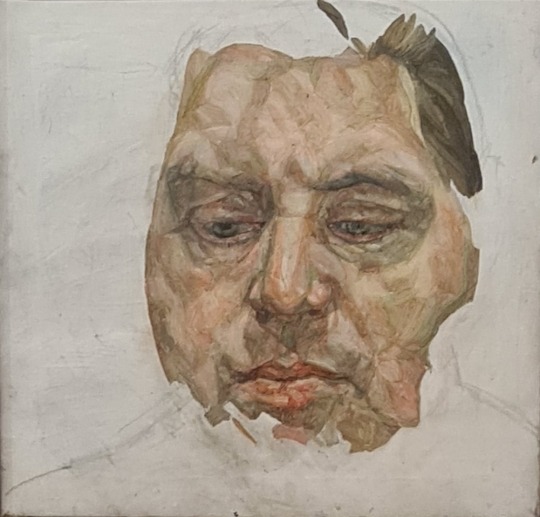
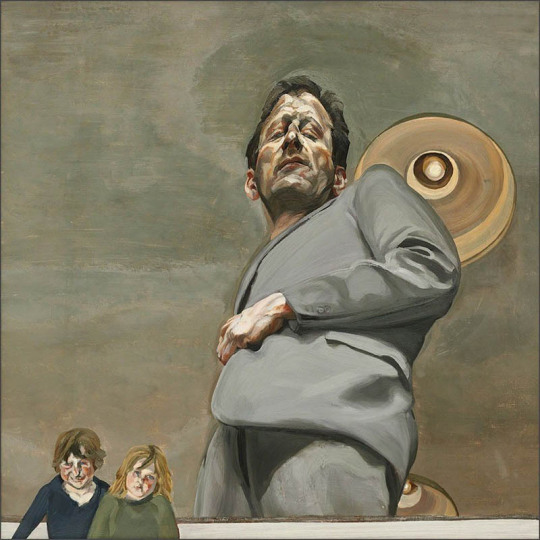

Wat? Man with a feather (1943), Hotel bedroom (1954), Selfportrait (fragment) (1956), Francis Bacon (unfinished) (1956-57) en Reflection with two children, selfportrait (1965) door Lucian Freud en ter vergelijking: beelden van farao Ramses II met aan zijn voeten zijn vrouw Nefertari en kinderen
Waar? Tentoonstelling Lucian Freud – A New Perspective in de National Gallery, Londen (en Abu Simbel, Egypte)
Wanneer? 6 januari 2023 (en 1 november 2015)
Man with a feather is een vroeg werk van Lucian Freud. Hij was 21 toen hij het schilderde. Het is een mysterieus, haast surrealistisch schilderij. Het is een zelfportret met een veer in zijn hand. Op de achtergrond zien we een huis met drie ramen. In één raam zit een vogel, in een ander staat een man. Gaat de man springen of geniet hij alleen van het uitzicht? En is die vogel misschien de ‘leverancier’ van de veer die de man vasthoudt? En wat zijn de vreemde vormen op de grond? Bladeren? Het antwoord is aan de beschouwer, die aan dit schilderij zijn eigen interpretatie kan geven.
Hotel bedroom toont een hotelkamer met daarin twee mensen: Freud en zijn toenmalige vrouw Caroline Blackwood. De vrouw ligt in bed. De vrouw heeft een bezorgde blik en houdt haar hand met de vingers licht gespreid tegen haar wang. De man staat voor het raam en kijkt met een wat sombere blik neer op zijn vrouw. Mij doet de scène denken aan schilderijen van Edward Hopper. Twee mensen zijn samen, maar tegelijk volledig op zichzelf en van elkaar gescheiden. Het werk is vaak in verband gebracht met huwelijksproblemen. Hoewel het paar die inderdaad had (ze zijn vijf jaar later uit elkaar gegaan) is de scène in gezamenlijk overleg bedacht en ontworpen.
Twee portretten: één van de schilder zelf en één van zijn vriend en collega Francis Bacon. Beide zijn onaf. Ze zijn echter niet toevallig onaf gebleven, maar zijn opzettelijk zo gemaakt. Daarmee passen ze in de traditie van non finito: kunstwerken die niet zijn voltooid. Het bewust onvoltooid laten van een schilderij kan bedoeld zijn om te tonen hoe excellent een kunstenaar is. Zijn werk is zelfs in onvoltooide staat een kunstwerk. De vraag wanneer een kunstwerk ‘af’ is, is sowieso een heikele kwestie. Sommige schilders laten bewust delen van het canvas onbeschilderd. Anderen, zoals Willem de Kooning, bleven jarenlang verbeteringen aanbrengen. Wanneer is een kunstwerk werkelijk af? De twee portretten van Freud passen ook nog in een andere oude traditie: die van de vriendschapsportretten. Kunstenaars die bevriend zijn en elkaar schilderen, komt in de kunstgeschiedenis vaak voor.
Gelukkig hangt ook mijn favoriete Freud op deze tentoonstelling. Ik schreef er eerder over toen ik het zag in de Royal Academy in 2020. Het is Selportrait with two children. Ik schreef toen dat zijn dochter ooit lachend vertelde dat haar vader nog iets nodig had voor in de linkerhoek: “We hadden ook een bloempot of een hond kunnen zijn”. Dit bleek echter een anekdote die niet op waarheid berust. Freud baseerde dit werk op Egyptische beelden, waarbij de vader hoog boven zijn kinderen uittorent. Een mooi voorbeeld daarvan zag ik tijdens mijn Egypte-reis bij de tempel van Ramses II in Abu SImbel.
6 notes
·
View notes
Text
Artist Video And Article Reflection
Figure Drawing Assignment 9/14
Alice Neel
Born in 1900 in the small town of Colwyn, Pennsylvania, Alice Neel would paint what many people wouldn’t expect, especially as a woman artist of the time. When moving to Spanish Harlem during the great depression, Alice was exposed to the struggles of everyday life and the people that had to live it. This inspired her to paint a multitude of people from almost every background. Regarded as a “colllector of souls”, most of her paintings revolved around a human subject being the focus while trying to convey a very deep sense of mood and emotion with expression, posture, and setting.
Willem De Kooning
Willem De Kooning, born in Rotterdam in 1904, is well known for the role he played in defining abstract expressionism. In the world of art, he is widely regarded as a “great American master”. De Kooning's artistic journey began at a young age when he apprenticed at 12 to a local painting and decorating firm and later studied at the Rotterdam Academy of Fine Arts. After moving to New York, his primary subject became the male figure. In 1943, he married Elaine Freed, which influenced a significant change in his artistic style by including the female subject more prominently than ever before in his work. In 1960, after the birth of his daughter and separating from Elaine, he purchased a house in Springs near East Hampton. This change of environment inspired his work, infusing his paintings with light and great inspiration from the natural landscape of his new home. In his later years, De Kooning's art evolved into a more loose and light style while still maintaining a strong sense of structure and composition.
Lucian Frued
British painter, Lucian Freud, redefined the human form in art by challenging the conventional methods of depicting the naked body. Despite facing skepticism in the art world, Freud's reputation grew over time as more people began to understand his work. In the 1940s and 1950s, he gained recognition for his portraits and emotionally charged scenes. As Freud's artistry matured, the creation of intensely detailed and grotesque nudes in the later years of his career emerged. Freud's fascination with the individuality of his subjects, both in terms of their bodies and faces, set him apart. Freud's work is characterized by his meticulous attention to form and his signature technique of harsh swiping and jagged marks. His unique portrayal of the human body, both in its wrinkled and vulnerable state, is a testament to his willingness to show his unvarnished reality.
What impressed me the most about all of these artists is their boundary pushing efforts to convey the way they see the world over conventional forms of art. With each of them having such a unique style and upbringing its hard to say which one of them is most impressive. Despite the styles of each of these artists being completely different, they all share a strong passion and perspective for the work they’ve done as artists in their time.
My favorite artist of the three would have to be Willem De Kooning. Especially shown in the art of his later years, his style and flow shown on the canvas seemed so controlled and deeply thought out. I strive to develop that level of control over a medium as Willem has developed with abstract painting.
1 note
·
View note
Text
De Kooning to Gorky
Willem de Kooning is someone that I believe is a truly incredible artist. De Kooning was a Dutch-American abstract expressionist artist who was known as an “action painter”. His artwork depicts emotive gestures and his abstract pieces were in order to abandon other artistic movements. For me personally, I feel that De Kooning’s paintings are something that I enjoy, not only because they are beautiful to look at, but because the way they are painted seems to be something that could be achievable to someone like me. Just paint on a canvas. No matter how I feel, I’d paint just to paint, no pressure.
My favorite painting from De Kooning, and possibly ever, happens to be Composition. It was painted in 1955, a sort of transition style between his Women collection and Whose Name Was Writ in Water, a sort of landscape collection. No one really knows why or what the painting is of, some say it could be women in a landscape, others say it’s neither, just nothing at all but emotional pain(t) thrown onto a canvas. As De Kooning had ADD, I feel that maybe he just was at that point where he lost focus, then regained his hyper focus again with the landscape collection. As he had moved into the frantic energy of New York City that year, it is likely all these emotions might have built up into… this. Art.
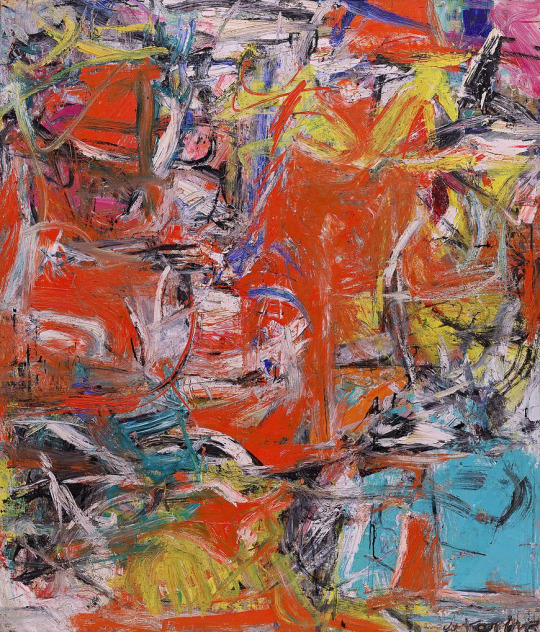
(Composition 1955)

(Untitled XXXIII 1977)
Several artists influenced De Kooning in many different ways, and it truly showed in his art. He gained influence from John Graham’s artistic ideas, and valued Stuart Davis’ urbane modernism. He was extremely impressed with Picasso’s retrospective art of Cubism and Realism that he felt powerfully influenced by when he saw exhibitions at MoMA in 1936. However, in an interview of De Kooning with David Sylvester for the BBC in March 1960, he confessed that Arshile Gorky was truly his biggest stylistic inspiration. In this quote, belies his true influence and reasoning, “I met him [Arshile Gorky] in 1929. Of course I met a lot of artists, but then I met Gorky. Well I had some training in Holland, quite a training, you know, The Academy. And then I met Gorky [in New York], who didn't have that at all, he came from no place [Tiflis, Armenia]... And for some mysterious reason, he knew lots more about painting, and art, he just knew it by nature - things I was supposed to know and feel and understand - he really did it better. He had an extraordinary gift for hitting the nail on the head, very remarkable, so I immediately attached myself to him and we became very good friends…“. Strangers who became foreigners to the United States, who influenced then became attached and ultimately, the greatest of artistic friends.

Arshile Gorky was an Armenian-American and was important as the direct link between the European Surrealist painters and the painters of the American Abstract Expressionist movement. Gorky made art on a canvas with oil paint, and also drew quite frequently with colored pencils. He had taken an apprenticeship with Pablo Picasso and many other great artists, however his aim was never to merely imitate the work of others, but to assimilate fully their aesthetic vision and move beyond it. Gorky was one of the major forces behind the abstract expressionist movement. His groundbreaking work fused mysticism and emotion, his subconscious thought, and the influences of previous modernists into a more abstract form. Gorky was greatly influenced by his home country and childhood as a refugee that inspired him to start painting. As he became more skilled, he took an acute interest in European painter predecessors, and used their influences to create his own work beyond the simple. However, in his later years his abstractions took on a darker and brooding hue after many tragedies that he faced. It began with his studio burning, then he was diagnosed with rectal cancer, and ultimately got into a car crash that left him with a broken neck. Gorky had then fallen into a deep depression and took his own life shortly after.

3 notes
·
View notes
Text
Sonia Mangiapane is a photomedia artist, employing media and processes defined primarily by their use of light, as opposed to the exclusive use of the camera. Working with a range of camera-based and cameraless processes she approaches the expanded field of photography as a medium of light writing, rather than purely a medium of representation. Guided by her fascination with the physical properties and ethereal qualities of light she explores concepts relating to journey, place and notions of time.
In 2020 she received a Master of Arts in Fine Art & Design: Lens-Based Media from the Department of Lens-Based Media, Piet Zwart Institute, Willem de Kooning Academy, Rotterdam.
Her thesis ‘wa/onderings: expanded notions of light, space + time in photomedia’ can be found here.
More: snmngpn.com
0 notes
Text
A vanishing voice.
Unlearning your dialect is the price you pay for a better future.
As a little human, you go from babbling to small words, from words to sentences and from sentences to conversations. The most important people in your life teach you how to speak, interweaving their speech features such as accents in dialects into your way of speaking. By this they transfer parts of their culture, heritage and identity into yours. It gives you a feeling of belonging, warmth and home. But when these people who taught you your dialect vanish, do the words we hold on so dearly disappear with them? Will it only be a memory?
Dialect is a linguistic feature that enriches your identity and portrays the proudness of your heritage. Although this is a beautiful thing, there are many biases about speaking dialect that have an effect on how easy your path in life will be. People are seen as dumb, antisocial, poor or lesser than people that speak “General Civilized Dutch”. This has an effect on the chances they get on the labor market, social situations and other chances they get within society, and therefor is discrimination based on linguistic features.
To get more in dept about this part of my research I will speak to creative copywriter and director Susan Zwijgers. She was born in Brabant and has lived there her whole youth. After graduating the Willem de Kooning Academy she went to the creative center of advertising in the Netherlands, Amsterdam. When applying for jobs, she encountered several biases about her speech. Due to rejection after rejection, she decided to actively unlearn her dialect. After this she finally got her dream job, but at what cost? I wonder if she regrets unlearning the dialect and what biases she encountered in her job search.
The educational system is very aware of this problem and instead of finding a way to let 2 languages live next to each other, they encourage to unlearn your dialect which indirectly means losing a part of your identity. Also, people who want to grow on the social ladder and apply for a higher job, try to unlearn their dialect themselves to increase their chances for the position. This way dialects are vanishing and are less and less spoken by the current and next generations.
To highlight the different perspectives in the education system about this topic, I speak with 2 primary school teachers. One in favor of using dialect in the classroom, the other against it. What are their arguments and to they think there is a middle ground?
The goal of this research is to show how ridiculous it is to think that speaking a dialect negatively influences people their intellect, creativity, wealth or social skills in any way and that dialect can live next to the existing curriculum so that we can preserve all these unique dialects. I want people to see the value of being unique and to preserve that trait.
Bibliography:
NOS op 3. “Dealen Met Je Dialect: Op Je Werk | NOS Op 3.” YouTube, 22 Sept. 2017,www.youtube.com/watch?v=1Kc2uPZ2AJE.
“Waarom Hebben We Vooroordelen Over Dialecten En Accenten? - BNNVARA.” BNNVARA, www.bnnvara.nl/artikelen/waarom-hebben-we-vooroordelen-over-dialecten-en- accenten.
“Dealen Met Je Dialect: Trots Op Je Taal | NOS Op 3.” YouTube, 24 Sept. 2017, www.youtube.com/watch?v=ykQ6twtLMw0.
“Steeds Minder Mensen Spreken Dialect, Gaat Het Verdwijnen?” DPG Media Privacy Gate, www.ad.nl/play/productie/steeds-minder-mensen-spreken-dialect-gaat-het- verdwijnen-328820.
“Dealen Met Je Dialect: Uitschelden En Uitlachen | Nos Op 3.” YouTube, YouTube, 23 Sept. 2017, www.youtube.com/watch?v=MRnU8ZII5ZU.
1 note
·
View note
Text
10/25 - Painting 2 - Reflection post for three videos about Wayne Thiebaud
CBS Sunday Morning - Wayne Thiebaud
For CBS's dedicated segment to Wayne Thiebaud and his work, Thiebaud explains how he created his own approach at painting food. He makes his paintings of food grab the viewer's attention through the use of texture, which is especially relevant in how he paints pies and cakes. For example, with how he paints a whole lemon meringue pie, he approaches it with lots of texture and attention to realism to make the viewer feel like they could actually touch and eat it. Even though Thiebaud has worked with a variety of subjects, his work primarily focuses on highly detailed studies of sweets and desserts, mainly cakes and pies. Thus, he has been given the title of the "dessert painter" and has expressed that he does not mind the label being put on him. Following up on his work after WW2, he would struggle to find a gallery that would accept his work. He would eventually find an art dealer by the name of Allan Stone and both Thiebaud and Stone would see to it that the work would be set up for a dedicated show at the Allan Stone Gallery in 1962. The show proved to be a near sell-out and even caught the attention of the MoMA (Museum of Modern Art)! Thiebaud would then be at the front of the uprising of pop art during the 60's and beyond. In addition, the National Academy of Design around the mid-2000's had honored him and his work with awards and mass recognition amongst artists young and old! Whenever viewers would gaze upon his work, they would get a strong sense of integrity and joy in living and food regardless of their perspectives on it. More importantly, Thiebaud had described that viewers would hopefully find some humor in his work, because in his own words, "If we don't have a sense of humor, we lack a sense of perspective."
2. The Morgan Library and Museum - Wayne Thiebaud, Draftsman
An interview staged with Thiebaud states that he had surprisingly not though about portraying sweets and desserts whenever he started painting. After a conversation with renowned abstract expressionist painter Willem de Kooning, Thiebaud had realized that finding your purpose in art is to hold onto something that you like or enjoy, with you having a special connection with that one thing you set out to paint. With those words in mind, he would take a year off of teaching art classes for military soldiers and has wanted to go back to very basic shapes. Drawing ovals, cones, triangles, and so on, he would call back to when he worked at local restaurants and serve rows of "American" food. This includes, but is not limited to: lemon meringue pie, burgers, pumpkin pies, ice cream, and slices of cake. He described his process of portraying these objects as almost like a dream, where he was in a sort of flow state and would feel connected to painting these simple but enjoyable treats. He would feel very close to painting these foods, because he had caught interest in painting them amongst many other delectable sweets. At times, he would still go back to reflecting on his work would have made him unable to be taken seriously, yet he would put that aside and still keep painting them because he developed genuine interest in doing so.
3. Christie's Interview: "I Knew This Was Not a Good Career Choice"
As part of another in-depth interview with Thiebaud and auction organization Christie's, Thiebaud goes into detail about how painters would take the concept of painting that is described as still and quiet and breathe new life into it. Moreover, Thiebaud refers to the medium of painting as alternate worlds being created. With painting, you have an unlimited set of tools and techniques to learn and with no limitations on that power, you would feel, as he would say, "omnipotent" as a painter. With all of that power, painters start to give viewers a peek into their own little worlds. With decades of experience teaching and painting, Thiebaud knew well ahead that this career was not a good choice for him. Thiebaud would mention that most of his fellow painters and colleagues would barely be able to survive and had to take other jobs to stay financially afloat. However, he does not believe in the idea of success for painting. He would go as far as to say that whenever he surrenders to the idea of success, he would lose something special. He admits that he was lucky, but he would explain that as a painter or artist, you would not be able to make a living off of it, but you can definitely make a life out of it. Thiebaud sees his paintings as abstractions, with constant measurements through rows of objects each one being angled slightly. Therefore, he makes sure to capture a feeling of reduction or "human touch" with his pieces. He makes the viewers' emotions feel intertwined with the piece by experimenting with various subjects and textures. Although his work is relatively simple, he is glad to find people finding pleasure and humor in his work since it reminds us of joyous foods.
0 notes
Text
Asema van Loëlle Monsanto wint de Filmfonds Wildcard op NFF
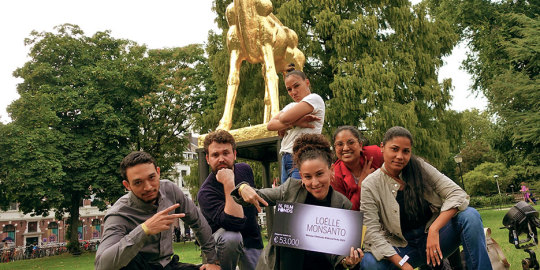
De Surinaamse afstudeerfilm Asema van Loëlle Monsanto heeft de Filmfonds Wildcard gewonnen op het Nederlands Filmfestival 2023.
De uitreiking van de NFF-Studentcompetitie en wildcards vond plaats op maandag 25 september tijdens de NFF-Talentendag en Award Ceremonie in Stadsschouwburg Utrecht. Met deze talentcompetities steunt het Nederlands Filmfestival de ontwikkeling en carrières van een nieuwe lichting makers.
Asema, de zesde aflevering van Sranan Folktales werd genomineerd voor de EY Talent Award; productie met de hoogste production value. De winnaar krijgt 5000 euro voor een volgend filmproject en een op-maat-gemaakt coaching traject. De jury was zeer onder de indruk: “Wat ons opviel aan Asema is de prachtige locatie van de film, namelijk het betoverende Suriname. Hier heeft het toegewijd team van acteurs en filmmakers het hartverwarmend verhaal verteld van Deon, een jongen die in de zomervakantie bij zijn oma logeert. Dat de productie in Suriname is opgenomen toont niet alleen een ambitieuze visie, maar ook het doorzettingsvermogen om een authentieke setting te creëren voor een verhaal met ontzettend veel cultuur. Het acteerwerk van de jonge acteurs verdient ook veel lof, die het verhaal op een oprechte manier overbrengen. Asema is dus niet alleen prachtig qua beeld, maar ook in teamwerk en verhaal.”
Helaas ging de EY Talent Award niet naar Asema, maar naar de animatiefilm Zeze & Mercedes van Bașak Kirici die is afgestudeerd van de Willem de Kooning Academie. Na diepe teleurstelling aan het begin van de Award Ceremonie werden helemaal als laatst de winnaars van de wildcards bekendgemaakt. Het Nederlands Filmfonds reikt jaarlijks zeven wildcards aan regisseurs voor het realiseren van een nieuwe digitale cultuurproductie, documentaire, animatie- of fictiefilm. Alle veertig geselecteerde studentenfilms maakten kans op de Filmfonds Wildcards. Monsanto en haar aanwezige crewleden geloofden niet dat ze veel kans maakten op een Wildcard vanwege de hoge concurrentie. Totdat het Filmfonds in haar speech enkele hints liet vallen, waaronder “jongeren” en “horror”. Vol spanning wachtten Monsanto en haar crew op het winnend fragment dat zou worden afgespeeld en tot hun grote verrassing wonnen zij de Wildcard in de categorie fictie ter waarde van 53000 euro inclusief het op-maat-gemaakte coaching traject. Een ware plottwist kan je het bijna noemen.
Monsanto is in extase en kan het nauwelijks geloven. “Het voelt zo geweldig om deze bevestiging te ontvangen dat we goed bezig zijn,” vertelt ze enthousiast. Ze heeft al vele plannen klaarliggen en kijkt ernaar uit om het coachingstraject te starten met het Filmfonds. “Ik ben de sponsoren en donateurs enorm dankbaar voor het geloven in mijn film, want zonder hen waren we zeker niet genomineerd voor de productie met de hoogste production value,” vult ze aan.
Read the full article
0 notes
Text

Designed this poster three years ago for the Body of Art performance elective at the art academy I studied at, and even printed it out to hang around the university.
#body of art#elective#performance art#flyer#flyer design#graphic design#graphic design is my passion#Willem de Kooning Academy#WdKA#design#poster#poster design#portfolio#Cinema 4D#4D art#printmedia#print#print media#media#media design#bitmap#dither#bmp
1 note
·
View note
Text
[09/14/2023] - Three Videos -
ART1330C
[Artist Alice Neel, a collector of souls]
- In this video Artist Alice Neel explains that the reasons she painted was to catch life as it went by. She is described as unflinching and candid, she has an egalitarian streak about her. Her artworks mainly focused on people she refused to create the abstract expressionism that was more prevalent at the time.
[Willem DE KOONING in his studio]
- In this video it explains how artist Willem de Kooning became one of the most influential painters of the 20th century. His works are among those that defined abstract expressionism. Kooning received formal training at the rotterdamn academy of fine art and techniques were he learned to draw from models and rebdering traditional subjects such as still lifes.
[Willem de kooning: Works on Paper]
- In this video artist Willem de kooning his techniques and philosophy when it comes to creating the artwork that he paints.
0 notes
Video
vimeo
CONNECTING IDEAS from Tiago Campeã on Vimeo.
Abstract animation based on moods, using sound as a starting point.
Having focused about the progression of the music, my concept was to describe creative process as a gather of ideas. Starting to appear individually, those will end up to make sense, when combined, in order to build and become something real.
Project developed at Willem de Kooning Academy, Hogeschool Rotterdam.
Music: "Vessel", by John Hopkins
0 notes
Text
Notes #1
Willem De Kooning -> De Kooning was one of the many artists that helped define the abstract expressionism movement of the 20th century. He was born in 1904 in Rotterdam and soon at the young age of 12 became an apprentice to a painting/decoration firm. On top of this, he would attend Rotterdam Academy of Fine Arts to future increase his education during the night while still working. There, he would get formal training and learn to draw traditional subjects. He became obsessed with the avant-garde movement later at the age of 22. He would emigrate to America on a ship to New Jersey, where he became a house painter and later on moved to New York City after. In New York City, he would be able to meet other painters such as himself, including Arshile Gorky and Stuart Davis. Kooning’s works would be a reflection of his love of abstraction and inspired by the surrealism movement and his friend Gorky’s own works. While his work is mostly abstraction, he was trained formally in figure painting and used to work closely with many male models, including his own friends as subjects. These friends included Rudolph Burkhardt and Edwin Denby. He would later in life meet a young art student named Elaine and they would marry in 1943, which Kooning would become inspired by and even draw her. He would draw a series of drawings featuring women, but in a 1948 exhibit at Charles Egan gallery, he would instead choose to feature his enamel abstract dynamic paintings. One of his more popular works is Woman I, which took him nearly 3 years to make as he constantly was working on it on and off. It was unique as it showcased the woman figure in the avant-garde style. A while after this, he and his wife would separate and he would move to the eastern end of Easter Island, and before his divorce he would have his sole child named Lisa Kooning. He would move to Springs in 1963 and constructed a huge studio to live and work in. Living at Springs would fuel his landscape passion as the sunsets, stillness of the water and much more would inspire him to draw. He would also go back to drawing women in his later years, changing his art style by using more vicious paint and broad strokes. These two concepts, landscape and women would be his central themes for the rest of his life. In the end, he returned back to what he knew best and learned, basic figure drawing and landscape.
Alice Neel -> Neel was an interesting artist and completely opposite from Willem De Kooning. As an artist her subject solely focused on people and highlighting their personality through the artwork. And oftentimes, the focus of her artworks were taboo things or art about subjects people at the time wouldn’t speak about. She was known as the “collector of souls” as she would capture her subject’s soul into her own artworks, making it feel as if you were right in front of a person instead of just looking at a painting. Her works are on display in the Metropolitan Museum of Art in NYC, where Neel hoped that people who would view her artwork would be shocked at what was depicted. Some of the subjects she drew were pregnant women naked, something that at the time was challenging's society views on women and how we treat and view pregnant women’s bodies. Neel was born in 1900 and grew up in Pennsylvania in a small town, which she frankly despised due to the closeted views and ideals the town held. So, when she was 21, she would leave the small town and would attend an all-girl school in order to focus on her studies and not be distracted by boys. This however, wouldn’t help her much because she stated she was good looking and would still attract many male admirers. In the end, she would end up chasing one of these boys, a Cuban named Carlos Enriquez, who she would go move to Havana in order to make art. In the end, however, their love was short and tragic, and they would separate and Neel would go through the hardest parts of her life. She would begin to draw people’s lives and capture them during this time, beginning with two young Spanish girls who lived in poverty. Neel didn’t capture an unrealistic sense of her subjects, she would capture the rawness and vividness of their character.
https://www.youtube.com/watch?v=qrpTCuaEKMk
https://www.youtube.com/watch?v=drSmmja15uY
https://www.youtube.com/watch?v=A4dLrnc5XPQ
Video and Article Reflection Post
What have you learned about all three artists?
Alice Neel was an artist who loved to paint artworks reflecting people living in the moment and often depicting people of varying races and backgrounds. She often drew things people weren't comfortable drawing, such as naked pregnant women. Her artworks depict people and the humanity in us all, and even some of her artworks reflect the pain and struggles she herself went through. Willem de Kooning was an artist who often paints extremely quickly and focuses on an abstract style. He looked up to artists like Picasso which gives his work a sense of style as it is composed of several different artists' styles. His compositions are extremely vivid and abstract in nature, but often changed up his style and never really stuck to one exact style. Lucian Freud as an artist was interesting as compared to the other two prior artists, his is much more realistic and less abstract or stylized. Most of his artwork features nude models, and most of his models are people he knew who he invited into his studio to model for him. One of the things I most noticed when viewing his artwork was his heavy usage of brown tones and nude colors, showing how much Freud loved to draw the human body. He truly was captivated by the human figure it being the only thing he ever drew, even his own final painting was a portrait of himself.
What impressed you the most about the way they work?
Each artist had a completely different style when it came to how they worked the canvas. Neel was more focused on her subject matter and capturing the essence of humanity in her artworks. Kooning had compressed several different art styles to combine his own unique style (such as Expressionism, Cubism, etc.) and often chose to paint women and mostly painted in a gestural form, which was helped by his way of working quickly with fast strokes. Freud chose a more realistic style, trying to stay true to the human body, and focused a lot of naked portraits. Most of Freud's works were based on models all from people close to him, from his friends to his own family, with a few expectations. Overall, what impresses me most about all these artists is how they were able to forge their own stylistic art and how they were able to depict what mattered most to them in an artwork.
Which is your favorite and why?
My favorite of all the shown artists would have to be Alice Neel. While each of these respectable artists has their own unique style which enables them to make such artworks, I feel like Neel's style paired with her subject matter makes for stunning pieces. Kooning had a more abstract style and Freud had a realism style going on, but Neel's was so unique because it wasn't just her style that gave life to her painting. It was the fact that her paintings would vary so drastically, portraying people of all types and backgrounds and having a focus on highlighting what makes us human. I think that aspect of her works makes it so endearing and makes it so that nearly everyone can find an artwork of hers and relate it to it on a more personal level.
1 note
·
View note
Photo

Jack Tworkov Polish-born painter Jack Tworkov (1900 - 1982) made his mark as a leading ‘Abstract Expressionist’ though he painted in other styles during his long career. Born in 1900, he studied English at ‘Columbia University’ and considered becoming a poet before turning his attention to art. He enrolled at the ‘National Academy of Design’ from 1923 - 1925, then took classes at the ‘Art Students League American’ 1900 - 1982. Between 1935 - 1941, Tworkov worked for the ‘WPA’ and began making connections with other future ‘Abstract Expressionists’ including Willem de Kooning. As a member of the ‘Eighth Street Club’ - a group of New York artists who began meeting regularly in 1951 - Tworkov was a key proponent of abstraction. In this heady atmosphere artists such as Tworkov, de Kooning, and Franz Kline discussed and debated their views on art. Scholars have identified two distinct periods in Tworkov’s Abstract Expressionist oeuvre - one occurring from approximately 1945 - 1954 - another beginning in 1954. The first phase is marked by a sensual and lyrical sense of line and abstract figuration. Loaded brushstrokes move across the surface of these gestural paintings enlivening the picture plane with pigment and texture. https://www.instagram.com/p/ChJlS8lMvW0/?igshid=NGJjMDIxMWI=
1 note
·
View note
Text
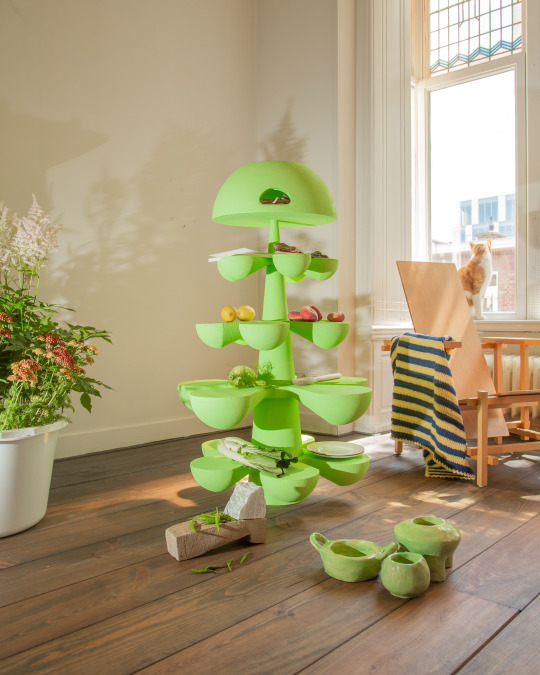

Non-Binary Kitchen (2022)
Non-binary Kitchen is a new age take on the kitchen, that aims to reshape the gender binary through its design. Collaboration and mobility were the key design goals that have been used to achieve this purpose. By means of bringing the kitchen design back to its primeval elements, the Non-binary Kitchen brings back a more labor intens form of foodwork, which simultaneously stimulates collaboration. The campaigns for “kitchenless” houses by the western feminist movements starting in 1978, inspired the work to be an object in space, mobile and reconstructible instead of the oppressive traditional fixed and/or separated kitchen design.
Year 2022 / Graduation Project; Willem de Kooning Academy / Rotterdam / Fine Art / Critical studies / Autonomous Practices
1 note
·
View note
